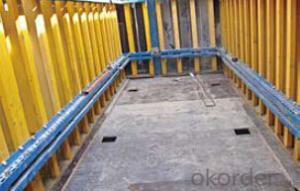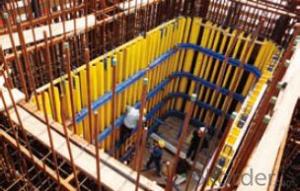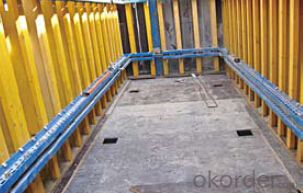Shaft-platform S40 System for Formwork and Scaffolding
- Loading Port:
- Tianjin
- Payment Terms:
- TT OR LC
- Min Order Qty:
- 50 m²
- Supply Capability:
- 1000 m²/month
OKorder Service Pledge
Quality Product, Order Online Tracking, Timely Delivery
OKorder Financial Service
Credit Rating, Credit Services, Credit Purchasing
You Might Also Like
Shaft Platform
As operating platform, the shaft platform is mainly used in the concrete pouring of elevator shaft,
equipment shaft, stair shaft of high-rise building and so on.
Characteristics:
◆ The length of shaft beam is adjustable.
◆ Flexible structure makes lifting easier.
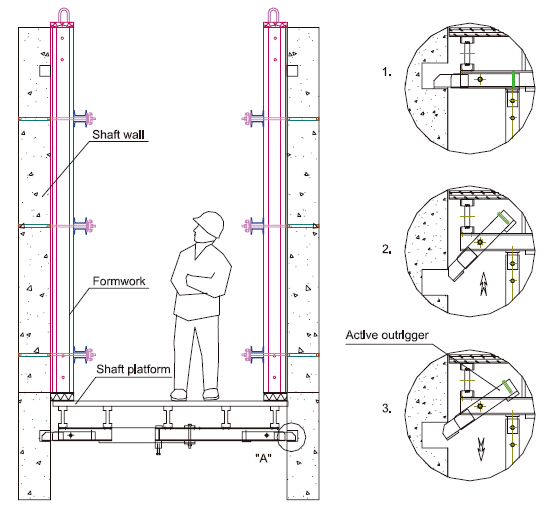
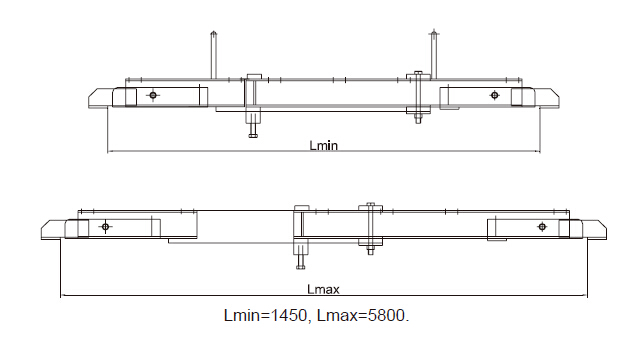
- Q: How does steel formwork handle formwork stripping and repositioning?
- Steel formwork is well-suited for handling formwork stripping and repositioning due to its inherent strength and durability. With steel formwork, the process of removing the formwork from the concrete structure is relatively easy and efficient. The steel panels or frames can be quickly detached and repositioned at the desired location, allowing for seamless reusability and adaptability. This flexibility and ease of handling make steel formwork a preferred choice for projects that require frequent formwork stripping and repositioning.
- Q: Are there any limitations to using steel formwork?
- Yes, there are limitations to using steel formwork. Some of the limitations include the high initial cost of steel formwork compared to other materials, the requirement for skilled labor to assemble and dismantle the formwork, and the need for proper maintenance to prevent corrosion. Additionally, steel formwork is heavy and may require heavy machinery for transportation and installation, making it less suitable for small-scale projects.
- Q: Can steel formwork be used for structures with high seismic resistance requirements?
- Indeed, structures with high seismic resistance requirements can utilize steel formwork. Renowned for its strength, durability, and stability, steel formwork is well-suited to endure seismic forces. Its rigid framework enables it to withstand lateral forces and vibrations caused by earthquakes. Steel formwork presents numerous benefits for structures with high seismic resistance requirements. Firstly, it provides a robust and dependable support system throughout the construction process, ensuring accurate placement and alignment of reinforcement and concrete. This guarantees proper connection and reinforcement of structural elements, thereby enhancing overall seismic performance. Moreover, steel formwork offers easy customization and adjustment to meet specific design requirements. This malleability facilitates the construction of intricate shapes and geometries, further fortifying the structure's integrity and resistance to seismic forces. Additionally, steel formwork enables efficient construction as it can be effortlessly assembled, disassembled, and reused, thereby saving time and resources. Furthermore, steel formwork boasts a high load-bearing capacity, which is essential for structures with high seismic resistance demands. It can bear heavy loads and distribute them evenly, minimizing the risk of structural failure during seismic events. Moreover, steel formwork exhibits exceptional durability and can withstand repeated use, ensuring its long-term performance in seismic-prone regions. In conclusion, steel formwork effectively caters to structures with high seismic resistance requirements. Its strength, durability, flexibility, and load-bearing capacity make it an ideal choice for withstanding seismic forces, guaranteeing the structural integrity and safety of the building.
- Q: Can steel formwork be used for post-tensioned concrete structures?
- Yes, steel formwork can be used for post-tensioned concrete structures. Steel formwork offers several advantages such as durability, reusability, and the ability to handle high pressure from the post-tensioning process. Additionally, steel formwork provides a smooth finish to the concrete surface, ensuring proper bonding and strength in post-tensioned structures.
- Q: Can steel formwork be used in high-temperature environments?
- No, steel formwork is not suitable for use in high-temperature environments. Steel has a high coefficient of thermal expansion, meaning it expands significantly when exposed to high temperatures. This expansion can lead to warping, distortion, and even structural failure of the formwork. Additionally, steel can lose its strength and load-bearing capacity at elevated temperatures, making it unsafe for use in high-temperature environments. It is recommended to use alternative formwork materials such as heat-resistant plastics or composite materials that are specifically designed for high-temperature applications.
- Q: How does steel formwork contribute to the overall constructability of the project?
- Steel formwork contributes to the overall constructability of a project by providing a durable and reusable system for creating concrete structures. It allows for efficient and accurate construction, as it can be easily assembled and disassembled, reducing labor and construction time. Its strength and stability ensure that the formwork can withstand the pressure and weight of the concrete, resulting in a high-quality and structurally sound end product. Additionally, steel formwork offers flexibility in design and can be easily adjusted to accommodate changes during the construction process, enhancing the overall constructability of the project.
- Q: Is steel formwork suitable for all types of concrete structures?
- No, steel formwork may not be suitable for all types of concrete structures. While steel formwork is versatile and durable, it may not be cost-effective or practical for smaller projects or structures with complex designs. Additionally, certain conditions such as extreme temperatures, corrosive environments, or high-rise buildings may require alternative formwork systems. Therefore, the suitability of steel formwork depends on the specific project requirements and considerations.
- Q: Can steel formwork be used for concrete beams with varying cross-sections?
- Yes, steel formwork can be used for concrete beams with varying cross-sections. Steel formwork is highly versatile and can be easily adjusted and customized to accommodate different shapes and sizes of concrete beams. It offers flexibility in terms of formwork design and allows for the creation of complex and irregular shapes. Additionally, steel formwork provides excellent strength and durability, making it suitable for supporting the weight and pressure exerted by concrete during the pouring and curing process. Overall, steel formwork is an ideal choice for constructing concrete beams with varying cross-sections, as it offers adaptability, strength, and reliability.
- Q: Are there any specific considerations for using steel formwork in areas with limited power supply?
- Yes, there are several specific considerations for using steel formwork in areas with limited power supply. Firstly, steel formwork typically requires power tools for assembly and disassembly. In areas with limited power supply, it may be challenging to operate these tools efficiently. Alternative methods such as manual tools or hand-held equipment may need to be used, which can significantly increase the time and labor required for formwork installation and removal. Secondly, steel formwork often requires welding or cutting, which typically relies on electricity. In areas with limited power supply, finding suitable alternatives for these processes becomes crucial. For example, gas-powered welding machines or oxy-fuel cutting equipment may need to be considered. However, these alternatives come with their own set of challenges, such as obtaining and storing fuel safely. Additionally, areas with limited power supply may also face issues related to lighting. Adequate lighting is essential during formwork installation and concrete pouring to ensure accuracy and safety. Using alternative lighting sources such as battery-powered or solar-powered lights may be necessary. Furthermore, steel formwork often requires proper cleaning and maintenance to ensure its longevity and reusability. Cleaning equipment, such as pressure washers or power scrubbers, may not be readily available in areas with limited power supply. In such cases, manual cleaning methods or low-power alternatives may need to be employed. Lastly, power supply limitations may also affect the overall productivity and efficiency of the construction project. With limited power, it may be necessary to carefully plan and schedule the use of power-intensive equipment, such as concrete mixers or pumps, to minimize disruptions and maximize the available power resources. In conclusion, using steel formwork in areas with limited power supply requires careful consideration and planning. Alternative methods, tools, and equipment may need to be employed to overcome the challenges posed by the lack of power availability. It is essential to assess the specific requirements of the project and consult with experts to ensure the successful implementation of steel formwork in such areas.
- Q: Can steel formwork be used for curved or irregular-shaped structures?
- Yes, steel formwork can be used for curved or irregular-shaped structures. Unlike traditional timber formwork, steel formwork offers greater flexibility and strength, making it suitable for complex shapes and designs. Steel formwork can be easily bent or fabricated into the desired shape, enabling the construction of curved walls, columns, and slabs. Additionally, steel formwork provides excellent support and stability, ensuring the accuracy and precision of the final structure. Its durability and reusability further make it a cost-effective choice for projects involving curved or irregular-shaped structures.
Send your message to us
Shaft-platform S40 System for Formwork and Scaffolding
- Loading Port:
- Tianjin
- Payment Terms:
- TT OR LC
- Min Order Qty:
- 50 m²
- Supply Capability:
- 1000 m²/month
OKorder Service Pledge
Quality Product, Order Online Tracking, Timely Delivery
OKorder Financial Service
Credit Rating, Credit Services, Credit Purchasing
Similar products
Hot products
Hot Searches
Related keywords
